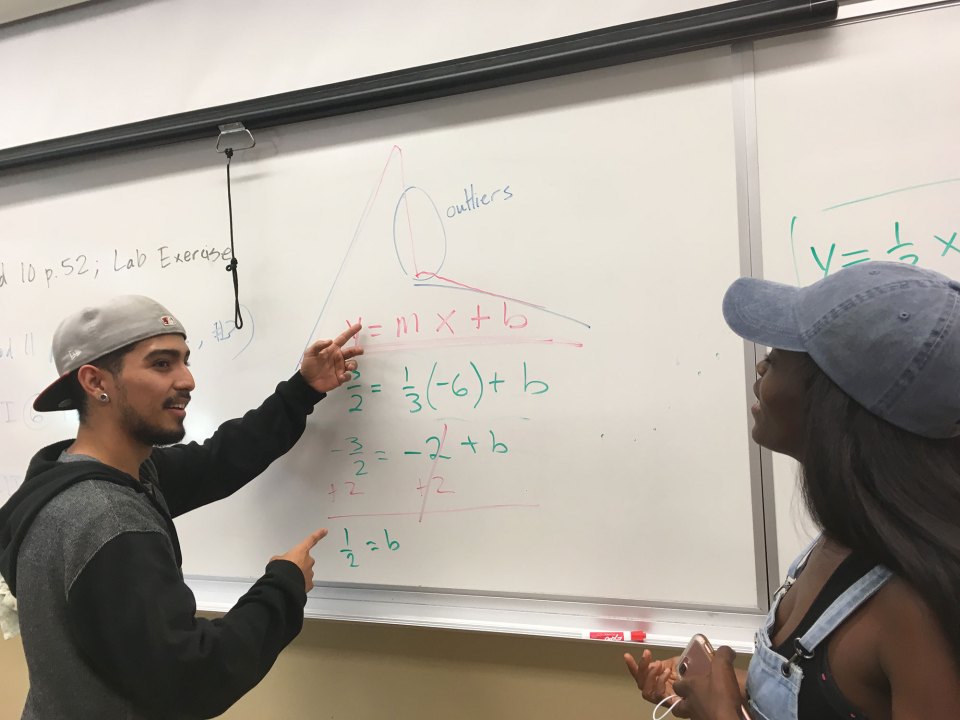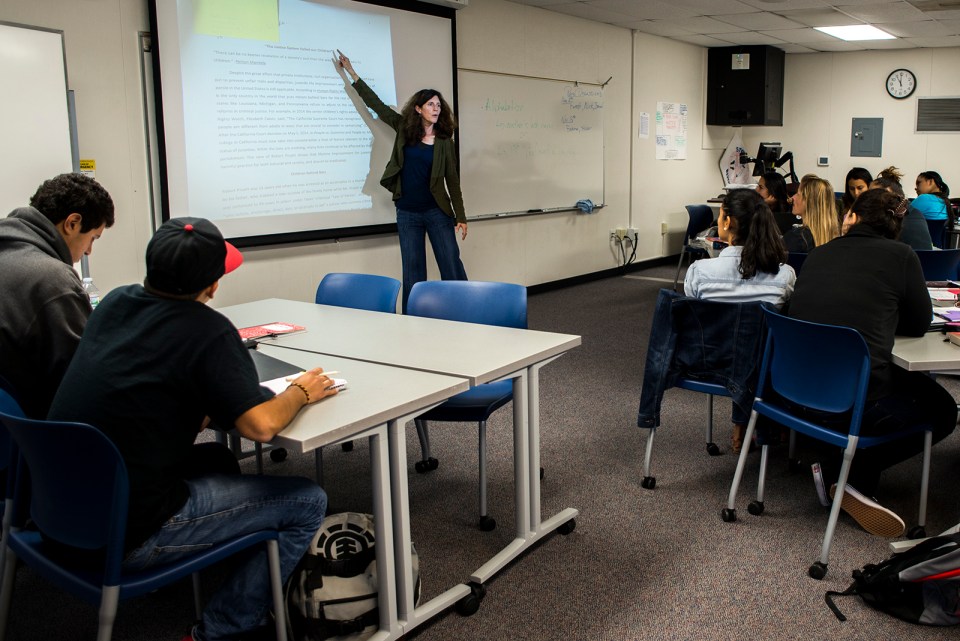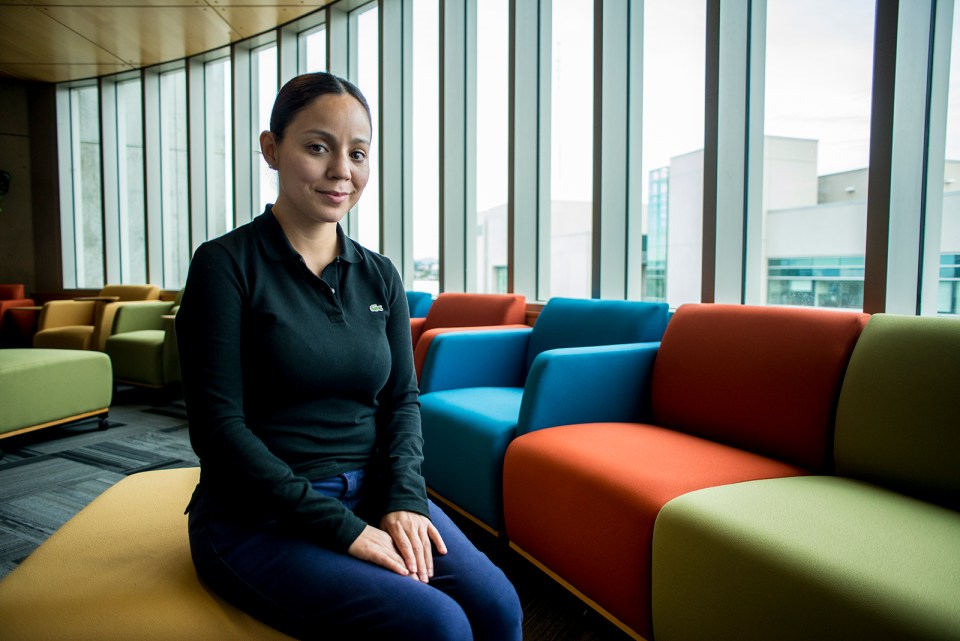
SAN DIEGO – Anthony Rodriguez recalled sitting in a remedial math class at Grossmont College, bored out of his mind. The professor was teaching basic math skills that the 18-year-old had already learned in high school.

Rodriguez was forced into remedial math by the community college’s placement test, which assesses a student’s ability to succeed in for-credit, higher education classes. Rodriguez’s placement test scores dictated at least a year of these low-level math courses. They cost the same as regular classes but don’t count toward a bachelor’s degree.
Each week, Rodriguez watched as fewer and fewer classmates showed up. Eventually, he dropped out too.
“Who goes to college to learn what they were doing in high school?” he asked.
In California, the answer is — a staggering number of people.
Hundreds of thousands of community college students are placed in remedial classes every year, and few get past them, especially few black and Latino students.
“There is no excuse for this,” said Julianna Barnes, president of Cuyamaca College. “It really is a civil rights issue.”
A Hechinger Report/inewsource analysis of California community college data yielded stark results. Only 1 percent of African-American students and 2 percent of Latino students who enrolled in the lowest level of remedial math in 2014 made it through an entry-level college math class within two years (the amount of time it’s supposed to take to earn a full associate’s degree).
“Having four levels of developmental math is like having a graveyard — almost no one gets out.”
At many community colleges, a student can start four levels below college level, which means they must pass four math or English classes before they are allowed to attempt a class that earns them credit toward a bachelor’s degree. Although whites and Asians also have poor pass rates in these low-level remedial classes, the inewsource/Hechinger Report analysis found that Latino students are twice as likely as whites to end up in the lowest level of remedial English. African-American students are five times as likely.
And in math, the situation is even worse.
“Having four levels of developmental math is like having a graveyard — almost no one gets out,” said Arturo Martinez, a math professor at El Camino College in Torrance, Calif.

The impact may be far-reaching: While close to half of all Asian-Americans and 41 percent of whites in California have bachelor’s degrees, the same is true for only 23 percent of African-Americans and 11 percent of Latinos.
The culprit, say experts and academics, has been the rules governing community college placement decisions. Almost anyone can enroll at a community college in California, but each college has its own process to decide how to place students. Even though state law requires colleges to consider more than just a standardized exam in this process, those exams have long been used as the deciding factor, despite questions about their accuracy.

In October, Gov. Jerry Brown signed a bill mandating that community colleges consider high school grades, grade-point average or coursework — not just placement tests — when assigning students to classes. It prohibits these schools from placing students in remedial courses unless those students are “highly unlikely to succeed in transfer-level coursework.”
It’s not clear how these changes will affect students throughout the state’s 114 community colleges. There is already significant resistance to the changes inside college math and English departments, with some educators concerned that the academic quality of current college-level courses will decline to accommodate unprepared students. They also worry that they will be unable to handle the influx of students who are not college-ready.
Gina Abbiate, a veteran math professor at San Diego Mesa College — where reforms are being piloted — believes changes in the law to reduce the number of students in remedial classes are good, but that the bill was rushed through without enough faculty input.
“It’s one thing to mandate to colleges that you cannot prohibit students from entering transfer-level classes,” Abbiate said. “But it’s another thing to actually have support systems to deal with the students that are there.”
Related: Most colleges enroll many students who aren’t prepared for higher education
Data show that most students who are placed directly into college-level classes pass at much higher rates than those who go through a remedial sequence, including those who went to low-performing high schools.
A statewide study by an independent nonprofit found that the most powerful predictor of success in college was grade-point average. On average, the study found nearly three-quarters of students with a 2.6 high school GPA passed college-level English. Roughly the same was true for college-level statistics.
Anthony Rodriguez has experienced that success.
After dropping out of Grossmont, which is in El Cajon, Calif., he began working more hours loading trucks at a UPS depot. Three years in, he decided he didn’t want to start work at 3 a.m. for the rest of his life. And he knew that a degree could net him a position as a mechanic, one that brought regular hours, job security and higher pay.
So last spring Rodriguez called Cuyamaca College, also in El Cajon, and took a math placement test.
It indicated he would need three remedial classes before being allowed into a transferable college-level class. But earlier that year, Cuyamaca had upended its remedial math program. Instead of relying solely on the placement test, Cuyamaca looked at Rodriguez’s GPA and the math classes he had passed in high school. These told him he could enroll directly in a college-level statistics class that provides extra support.
Rodriguez jumped at the chance.
Barnes, Cuyamaca College’s president, believes that educators often blamed non-academic issues for students’ failures.
“We kept saying, ‘Oh, it’s because they have issues at home, they have to work, it’s the public school system,’” she said. “We just kept pointing at the students as the issue, and we’ve finally flipped the mirror and are realizing, ‘Oh, wow, it’s us.’”
Cuyamaca now allows any student, regardless of placement exam results or GPA, to enroll in a college-level statistics course with what’s known as a co-requisite. The course covers the same material as the regular statistics class but requires two more hours of class time per week. Cuyamaca professors also made changes to the way they teach the material. The lessons include more hands-on problem solving and the students often work in small groups.
Instructors also are addressing common roadblocks for underprepared and first-generation college students.
“They’re capable of much more than they think they are,” said Rachel Krajewski, who has taught college algebra for the past two years at Cuyamaca.
“Sometimes when students fail their first test, they don’t come back,” Krajewski said. “We’re trying to move them from, ‘I don’t get it, I’m not good enough,’ to ‘I don’t get it yet.’”
VIDEO: Mesa College Professor Wendy Smith talks about placement exams
The results have been promising.
The California Acceleration Project, an advocacy group founded by faculty, reported that pass rates for underprepared students at Cuyamaca in college-level math jumped to 67 percent last year, up from 10 percent the year before. And all racial groups benefited — success rates were four times higher for Latinos, five times higher for white students and nine times higher for black students.
Rodriguez finished his summer statistics class with a B and is now taking English and automotive technology classes. He is on track to pass them all, even with his heavy workload at UPS, and hopes to earn his degree in 2019.
While the California Acceleration Project is aggressively pushing for changes, the Academic Senate for California Community Colleges, also comprised of faculty, opposed the remedial legislation that just passed.
Julie Bruno, president of the Academic Senate and a professor at Sierra College, outside of Sacramento, said that her group supports using additional measures, other than just a placement exam, to determine whether a student is ready for a college-level class. But she is concerned that the bill overreaches, mandating colleges to put in place a one-size-fits-all prescription. Community colleges have long had their own independent curriculum committees that control these decisions.
Different community colleges serve different populations, she said. “It really depends on where the students are coming from, who they are, what else is going on in their lives,” she said. “Not all high schools are created equal.”
Some community colleges have worked with their local high schools to make sure a student who receives a B in a senior English or math class is prepared for college-level work, she said, while others have not yet forged that relationship.
Abbiate, in the San Diego Mesa College math department, is concerned that the Board of Governors will force colleges into a rigid formula that determines where students get placed.
“As a math instructor, I know it doesn’t come down to percentages; I know it comes down to individuals,” Abbiate said.
She said whether a student has a strong fear of math, has been out of school for several years or has learning differences can determine whether a student will succeed in college-level classes.
“If faculty had given input, they would have said, ‘This is a good idea, here’s what we need to make it happen effectively,’ ” said Abbiate, “but we didn’t have that option.”
Gina Abbiate, a math professor at San Diego Mesa College, talks about the ramifications of the new California law AB705.
California is not alone in grappling with this problem.
In the fall of 2015, Tennessee stopped offering remedial classes at all of its public colleges and universities, moving to the co-requisite model where students take college-level courses with an extra support class to help them keep up.
According to the Tennessee Board of Regents, pass rates in math quadrupled, and success rates for students of color were six times higher. English pass rates followed a similar pattern, as did success rates for low-income students, adult students and students who had entered at low levels of preparedness, as measured by ACT scores.
The City University of New York phased out remedial classes at four-year colleges starting in 1999 and shuffled those students to the system’s community colleges. It launched several pilot programs, like the co-requisite model, with success, and plans to roll out a system-wide overhaul of its remedial system next fall.
Other state systems, such as those in West Virginia, North Carolina and Florida, have begun similar efforts.
In August, the four-year California State University system decided to get rid of all remedial classes.
A working group met in November to come up with guidelines for how California’s community colleges must revamp their approach to remedial education. All colleges must implement the changes required by the new law by the fall of 2019.

Diana Solares was aiming for a bachelor’s degree when she graduated from high school in San Diego in 2002. Her mother and father, who had emigrated from Mexico and Guatemala, didn’t go beyond third grade, and she was determined to be the first in her family to graduate from college. She did well in school and, aware of the requirements at the California State University system, she took chemistry, biology and earned a B+ in pre-calculus.
But when she took the placement exams at San Diego City College, she was placed at three levels below in math and one level below in English.
“It was very discouraging, having to start in pre-algebra,” said Solares, now 33. “I just felt that I was not college material.”
It took four years at San Diego City College, in part because of the multiple remedial classes she had to pass, before she transferred to the University of San Diego. By that time, she had exhausted all of her federal financial aid. Then a medical condition and the reality of raising two boys on her own got in the way, and she never finished.
She said her original dream of going to law school and teaching feels very far away, but she is still determined to get her degree.
“In high school, I was university focused,” said Solares, whose loans are in deferment for now. “I know I had the ability. I was looking forward to higher education. I didn’t know that it was going to take so much from me.”

Wendy Smith, an English professor at San Diego Mesa College, said Solares’ story is similar to many she has heard during her years of teaching. Her department first saw the data on how few students of color were making it through remedial classes several years ago, and started making changes in the fall of 2010.
Using students’ high school transcripts in the placement process meant that 82 percent of new students could take college-level English, instead of 28 percent previously, Smith said. The old way — using placement tests — felt to Smith “like a segregation machine.”
“We weren’t doing right by our students,” she said. “We were under-placing them, and the students who were under-placed, by and large, were students of color.”
The move quadrupled the number of African-American students who were passing entry-level English in one semester.
“I guess the thinking is, ‘They come to us with a deficit and, you know, what can we do?’ ” Smith said. “That was the prevailing point of view for a long time, that, ‘Yeah, it’s kind of too bad that we lose so many students of color, but that’s just the way our society is functioning.’
“Little did we know that we were a huge participant in that — in making sure they didn’t make it.”
This story was produced jointly by inewsource San Diego, a data-focused investigative news organization, and The Hechinger Report, a nonprofit, independent news organization focused on inequality and innovation in education. Sign up for our newsletter.


